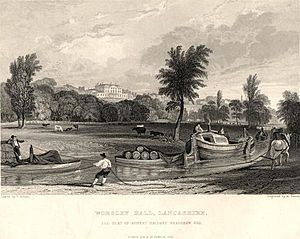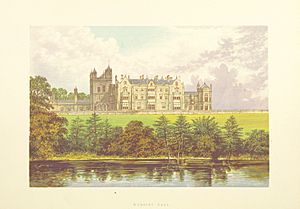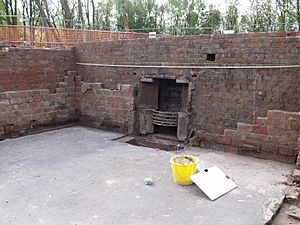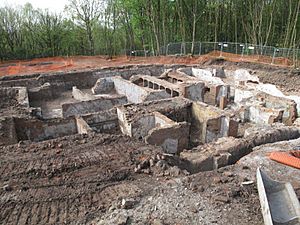Worsley New Hall facts for kids
Worsley New Hall was a grand mansion and beautiful gardens located next to the Bridgewater Canal in Worsley, Greater Manchester, England. It was about 8 miles (13 km) west of Manchester. Today, the gardens are being brought back to life by the Royal Horticultural Society (RHS). They opened as RHS Garden Bridgewater in 2020, becoming a wonderful place for everyone to visit.
Contents
Building a Grand Home
Long ago, in the 1500s or early 1600s, a house called Worsley Old Hall stood on this land. Later, in 1748, the estate was inherited by Francis Egerton, 3rd Duke of Bridgewater. He decided to build a new house, known as the Brick Hall, in the 1760s. It was built in a classical style.
The Brick Hall was later replaced by the even grander Worsley New Hall. This huge house was built for Francis Egerton, 1st Earl of Ellesmere. It was designed by a famous architect named Edward Blore. Building work started in 1839, and the first stone was laid in April 1840. The mansion was finished by 1846 and cost nearly £100,000, which was a huge amount of money back then! The old Brick Hall was taken down between 1844 and 1845. Today, Leigh Road runs over where it once stood.
Worsley New Hall was built in a style called Elizabethan Gothic. It was made from a special stone called Hollington stone. The Hall had three floors and looked very balanced, with a special wing for the family and another wing for the servants, plus a tall tower. The original plans for the building are kept safe at the Victoria and Albert Museum.
Famous Visitors
Worsley New Hall welcomed many important guests over the years.
Queen Victoria's Visits
Queen Victoria visited the hall twice. Her first visit was in October 1851. This was a very special event, as it was the first time a royal had visited the area in 150 years! Queen Victoria, along with Arthur Wellesley, 1st Duke of Wellington, arrived at the New Hall in a special boat. They traveled along the Bridgewater Canal from Patricroft station. During her visit, she met a famous engineer named James Nasmyth.
Queen Victoria's second visit was in 1857. She was in the area to attend a big art show called the Art Treasures Exhibition, Manchester 1857. While at the Hall, she planted a North American giant redwood tree to remember the Duke of Wellington. At the same time, Princess Frederica Maria of Prussia planted an English Oak. Sadly, the redwood tree did not grow well in the British weather.
Other Royal Guests
Edward VII and Queen Alexandra also visited Worsley New Hall in 1869, when Edward was still a prince. They returned on July 6, 1909, after opening the Manchester Royal Infirmary. This time, they came to inspect the Territorial Army's East Lancashire division. The soldiers were gathered on the hall grounds, south of the Bridgewater Canal.
The Hall in the 20th Century
World War I Hospital
During World War I, John Egerton, 4th Earl of Ellesmere, who owned the hall, kindly offered it to the British Red Cross. It was used as a hospital for soldiers who had been injured in the war. The grand rooms of the New Hall became hospital wards. Food came from the hall's own gardens, and the beautiful terraced gardens and parkland were used by the soldiers for relaxation. The hospital closed its doors in 1919.
Changes and Sales
After the war, in 1920, the 4th Earl had to pay special taxes called death duties. This meant he started selling off many of the hall's furniture and other items. Some furniture and paintings were moved to his other homes. The hall's library and extra furniture were sold at an auction in April 1921.
In 1923, the entire Worsley estate, including the New Hall, was sold to a group of businessmen for £3.3 million. The New Hall had been empty since the end of World War I. People tried to sell it in the 1920s and 1930s, but no one wanted to buy such a large, empty house.
World War II Use
During World War II, the military took over parts of the New Hall and its grounds. Soldiers from the Lancashire Fusiliers stayed there in 1939 and 1940. About 100 troops used the hall's basements as air raid shelters and dug training trenches in the grounds. Later, Home Guard battalions used the site for practicing street fighting inside the hall. Explosives were even stored in the grounds. The lake and other areas were used for scouting activities. The hall also provided shelter for people who had to leave their homes during the Dunkirk evacuation. In 1944, American soldiers were based there, getting ready for D-Day.
Sadly, in September 1943, a fire badly damaged the top floor of the New Hall. The building was also damaged by the soldiers who had stayed there. Windows were broken, and some furniture was even used for firewood. The house also suffered from dry rot and subsidence because of mining nearby.
Taking Down the Hall
Because of the fire damage and other problems, it was decided to demolish the New Hall. In 1944, offers were asked for to take down the building. The hall was sold to a scrap merchant for £2,500. Demolition began in 1946, and by 1949, the hall was completely gone, right down to the ground. The leftover pieces were used to fill in the basements. A lot of the stone from the New Hall, about 800 tonnes, was used to build new houses in Southfield, Yorkshire. A footbridge that connected the Old Hall and New Hall estates was also taken down at this time.
What Happened to the Site Later
In 1951, the military again took over part of the New Hall site. They built a strong concrete bunker where the servants' wing used to be. This bunker was later used by the Royal Navy as a food store. Over the years, it was also used by local councils and the fire service as a control center. In 1985, it was leased to a gun club as a shooting range.
The land where the New Hall and its gardens once stood was owned by Bridgewater Estates Ltd until 1984. Then, a company called Peel Holdings (now Peel Land and Property) bought it. For many years, people had different ideas for what to do with the site, like building a racecourse, a hotel, or a spa.
In 2011, archaeologists from the University of Salford started digging at the site. They found that some of the house's basement and foundations were still there! Between 2012, Peel also helped fund a community dig. This project helped collect stories from people who remembered the New Hall and found old records about it.
The Beautiful Gardens
Worsley New Hall had amazing formal gardens that were first designed in the early 1840s. They were improved even more over the next 50 years.
Garden Design
The famous garden designer William Andrews Nesfield started working on the gardens in 1846. By 1857, there were six beautiful terraces. These terraces were separated by stone railings and connected by steps and gravel paths. The top two terraces had very fancy designs, like embroidered patterns. The second terrace copied a design by a French designer. In the middle of this terrace was a bronze fountain that had been shown at The Great Exhibition in 1851. This fountain, and two others on the fifth terrace, used water from a nearby reservoir.
Close to the terraces were a croquet lawn and a tennis court. To the south of the terraces, there was a large parkland with a lake where people could go boating. The lake was made bigger by 1875 and even had an island grotto that you could reach by a footbridge.
Kitchen Gardens
To the west of the terraces, there was a woodland that separated the main hall grounds from the gardener's cottage and the kitchen gardens. These walled kitchen gardens were created in the early 1840s to grow fresh vegetables, fruit, and flowers for the people living in the New Hall. The kitchen garden was very large, about ten acres. Its walls were heated by special flues to make the area warmer for growing plants. The kitchen gardens also had sheds for potting plants and glasshouses where cucumbers, melons, grapevines, and peach trees grew.
The cottage for the head gardener was built in 1834 and designed by Edward Blore. A building called the Bothy was built later to house the unmarried gardeners. A boiler in the Bothy's cellar provided heat to the kitchen garden's glasshouses. Both the gardener's cottage and the Bothy are still standing today.
After the Earls of Ellesmere left the New Hall in 1914, the gardens were not looked after. The formal gardens became overgrown, and the beautiful fountain was damaged by the weather.
Royal Horticultural Society Garden
In October 2015, it was announced that the Royal Horticultural Society (RHS) would bring the 156-acre garden at Worsley New Hall back to life. It was planned to open in 2019 (later changed to 2020) as "RHS Garden Bridgewater". This is the RHS's fifth garden. The renovation cost £30 million, with £19 million coming from Salford Council. The goal is for about 1 million people to visit the garden each year.
The new gardens are being designed by Tom Stuart-Smith. The plans include a new visitor building, a new lake, and a beautiful entrance garden. There will also be a water garden, a learning center, and a café. The walled garden is being rebuilt and will have special areas for plants used in therapy, vegetables, and flowers. The terraces between the ornamental lake and where the hall once stood are also being restored, along with the tree-lined path leading to the estate.





